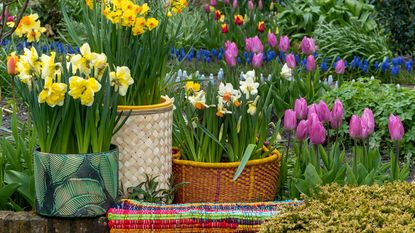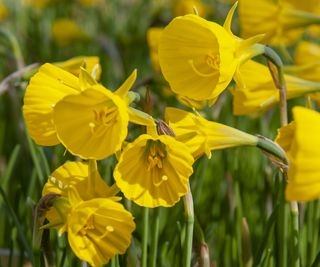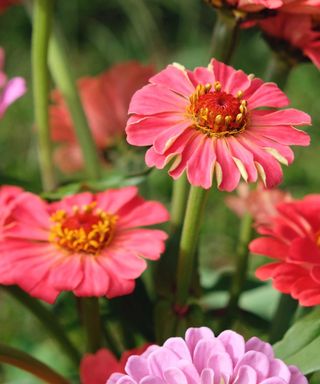US hardiness zone 5 explained
Expert advice on how to garden and what to plant in USDA hardiness zone 5


Hardiness zones are areas across the country whose average coldest winter temperatures are the same. They are shown in bands on the USDA Hardiness Zone map and numbered Zone 1 (the coldest) to Zone 13 (the warmest).
They’re important because - used alongside the hardiness ratings attached to individual plant varieties and noted on plant tags, websites and in catalogs - it’s easy to see which plants will survive the winter in your area.
In zone 5, rapidly warming spring days encourage a surge of new growth, especially in perennials and bulbs, so that the first flowers of summer may start to open when spring glowering bulbs are still colorful – flowering of roses and daffodils may overlap. The pond may still be frozen when the air temperature is 70F.
Annual flowers and leafy vegetables do well in zone 5 but may need protection against the final frosts, especially if the chills come after a week or two of warmer nights.

Gardening in US hardiness zone 5
In zone 5, average lowest winter temperatures fall in the range of -20F and -10F.
It’s important to remember that whether or not a particular plant will grow in your yard is also influenced by the local presence of mountains, large bodies of water, buildings and so on.
- Choose plants rated as suitable for zone 5, but be flexible. Some plants rated as zone 6 may well succeed in suitable garden microclimates in zone 5 and including them in your choice will widen your range of options.
- Hoop houses and low tunnels are helpful in adding a little growing time in spring and for frost protection in fall – even old bedsheets can be very effective against the final frosts of winter.
- Spring mulch will protect the crowns of perennials if the first shoots are frosted.
- Fences, walls, and hedges can screen plantings from warming spring sun so may hold back spring growth,
- Mature evergreen shrubs and small trees – in your own yard or nearby – can help create protected microclimates where the iciest frosts fail to penetrate allowing more plants can thrive.
- Many fruit trees do well in zone 5, but frost can damage the blossom, ruining the crop. Choose later flowering varieties that have proved successful in your local area.
- As always, mulch is invaluable – bark, garden compost, composted leaves, gravel (in sunny, well-drained areas) all help alleviate winter chills while black plastic helps raise soil temperatures in spring before planting a veg garden.
- Don’t be afraid to expect the unexpected: carefully chosen kiwi vines and cacti can thrive in zone 5.
Zone 5 main features

The average coldest winter temperatures in zone 5 fall to between -20F and -10F.
Zone 5a has a minimum average temperature of -20F to -15F. Zone 4b has a minimum average temperature of -15F to -10F.
Zone 5 includes parts of Montana, Wyoming and much of Colorado, southern South Dakota and Nebraska, and southern Minnesota. It also includes most of Iowa, plus southern Wisconsin, northern Illinois and Michigan, as well as much of New York, New Hampshire and Maine.
The ground in zone 5 mainly remains frozen until spring, but sudden warm days can thaw the top few inches while below that level the ground remains frozen. This creates standing water which may rot the crowns of some perennials.
The first frost date of the fall is usually about 13-21 October, while the last frost date of the spring is usually about 7-30 April.
Plants for zone 5

Although zone 5 winters are too cold for many plants, gardeners in zone 5 can grow a vast range of evergreen and deciduous trees and shrubs along with a wealth of vines, perennials and bulbs plus edibles and annuals.
All plants noted for zones 1 and 2, zone 3 and zone 4 are also suitable for zone 5.
Deciduous trees
Crabapple (Malus) Beautiful spring flowering trees with red, pink or white blossom followed by mini-apples in red, orange yellow and even white.
Paperbark maple (Acer griseum) An invaluable small tree with fiery fall foliage and flaking cinnamon colored bark.
Also try: Birches (Betula varieties)
Evergreen trees
Silver Korean Fir (Abies koreana) This neat, slow-growing conifer with dark green needles, white below, features striking purple cones even when young.
Japanese cedar (Cryptomeria japonica) From neat globes to weeping elegance, in many sizes and leaf colors. All are good.
Also try: Weeping hemlock (Tsuga canadensis ‘Pendula’).
Deciduous shrubs
American holly (Ilex verticillata) Easy to grow native with bright clusters of red, orange or yellow berries in fall and winter.
Ninebark (Physocarpus opulifolius) Adaptable native foliage plants with leaves in copper or bronze, deep blood red, amber and golden shades.
Also try: Smoke bush (Cotinus coggygria)
Evergreen shrubs
Andromeda bush (Pieris) Narrow foliage sets off the clusters of flowers like lily-of-the-valley in reds, pink and white.
Heather (Calluna) Low and spreading, in a huge variety of foliage and flower colors, good in containers and for edging.
Also try: Oregon grape holly (Mahonia)
Vines
Trumpet honeysuckle (Lonicera sempervirens) Clusters of long red or orange summer flowers. Avoid non-native honeysuckles as they may be invasive.
American wisteria (Wisteria frutescens) Pale lilac flowers on vigorously twining vines. Avoid invasive non-native varieties.
Also try: Climbing roses (Rosa)
Perennials
Bee balm (Monarda) Aromatic summer native with tiers of flowers in many shades. Look for mildew-resistant varieties. Very popular with bees
Peonies (Paeonia) Tough and tolerant, almost indestructible summer flowers in many flower shapes and colors.
Also try: Hardy hibiscus
Spring flowering bulbs
Grape hyacinth (Muscari) Low clump formers with upright, grape-like clusters of small blue, white or bicolored flowers. Spreads steadily.
Dutch iris (Iris) Brightly colorful flowers in a huge range of colors and color combinations. Easy, reliable and good for cutting.
Also try: Hyacinth (Hyacinthus)
Summer flowering bulbs
Indian shot (Canna) Tropical-looking temp-perennial for spring planting and exotic summer flowers, some with colorful leaves.
Dahlia: Thousands of varieties in many, many flower styles from dwarf to head high and in every color but blue. Essential.
Also try: Tuberous begonia (Begonia x tuberhybrida).
Natives
Coneflower (Echinacea) Large, upward facing daisies in red, orange, yellow, purples, pinks and white - single and double - with cone-shaped centers.
American witch hazel (Hamamelis virginiana) Exceptionally fragrant fall flowers in golden tones follow yellow fall foliage.
Also try: Fringe Tree (Chionanthus virginicus).
Annuals
China aster (Callistephus) Large, single or double, pastel daisies for summer borders and for cutting. Seeds can be started indoors.
Coleus (Coleus) Spectacular summer foliage plants with leaves in colors and color combinations not seen in any other plants.
Also try: Zinnia (Zinnia)
Vegetables
Cabbage: Many kinds, start seeds indoors a month before your last frost date and grow cool before planting.
Lettuce: Head and looseleaf lettuce can be started indoors then planted out to mature. Start cut-and-come-again types in flats indoors or outside, after the last frost.
Also try: Onions
Fruits
Grape vine: Grow your own black or white grapes to eat fresh or use to make wine. Focus on new, hardier varieties. Regular pruning essential.
Raspberries: Get local advice on the best red and black raspberries for your area.
Also try Blueberries.
FAQs
Which vegetables grow best in zone 5?
Many varieties of cool season vegetables such as lettuce, cabbages, kale, onions, spinach, carrots, and potatoes can be sown direct into the soil outdoors in April and May. Or start seeds indoors the month before and plant out after the final frosts have passed.
The breadth of crops, flowers and native plants you can grow in zone 5 is wide reaching, and allows for much more variety when it comes to planning your backyard ideas.
Sign up to the Homes & Gardens newsletter
Design expertise in your inbox – from inspiring decorating ideas and beautiful celebrity homes to practical gardening advice and shopping round-ups.

Graham Rice is a garden writer who has won awards for his work online, and in books and magazines, on both sides of the Atlantic. He is a member of a number of Royal Horticultural Society committees and the recipient of the 2021 Garden Media Guild Lifetime Achievement Award. He gardened in Pennsylvania for 20 years, but has recently returned to his native England.
-
 5 ways to fall back in love with your kitchen, even if it's not your dream space (yet)
5 ways to fall back in love with your kitchen, even if it's not your dream space (yet)Interior designers suggest 5 ways to love your kitchen even if it's not your dream space, and they're simple, easy solutions that make a big difference
By Molly Malsom Published
-
 12 Mother's Day gifts every home-loving mom will want to receive
12 Mother's Day gifts every home-loving mom will want to receiveMother’s Day is on May 12 this year, so it’s really time to start thinking about gifts. I selected my favorite options for Mother’s Day gifts available right now
By Nikhita Mahtani Published